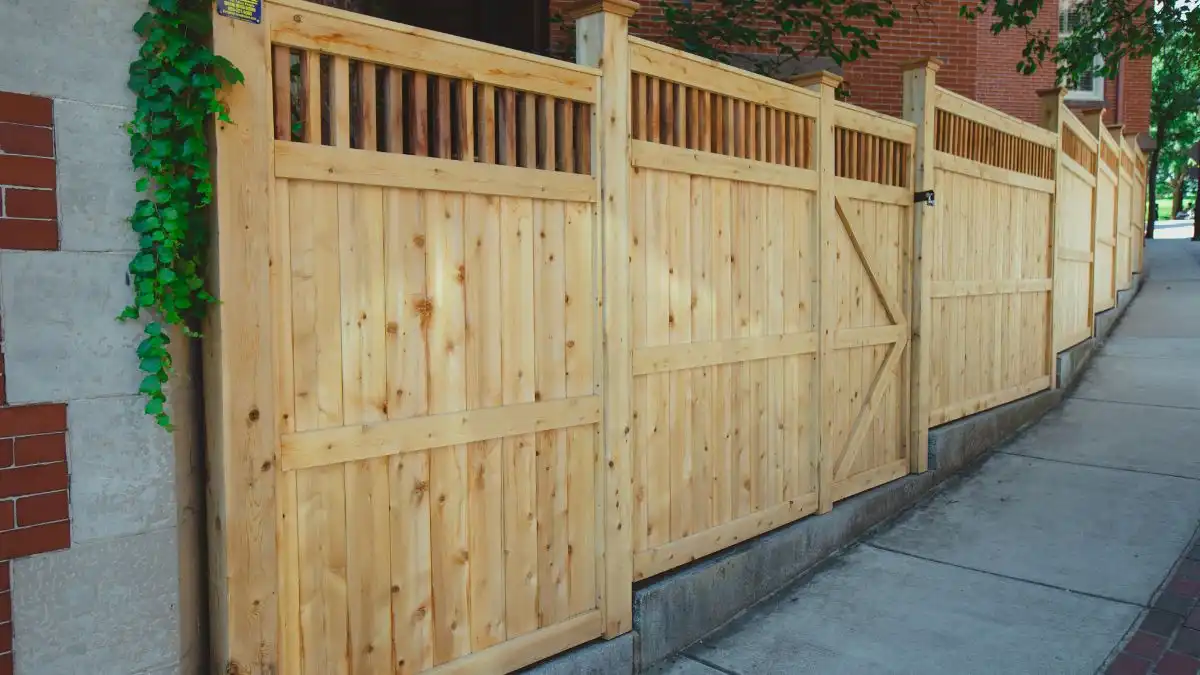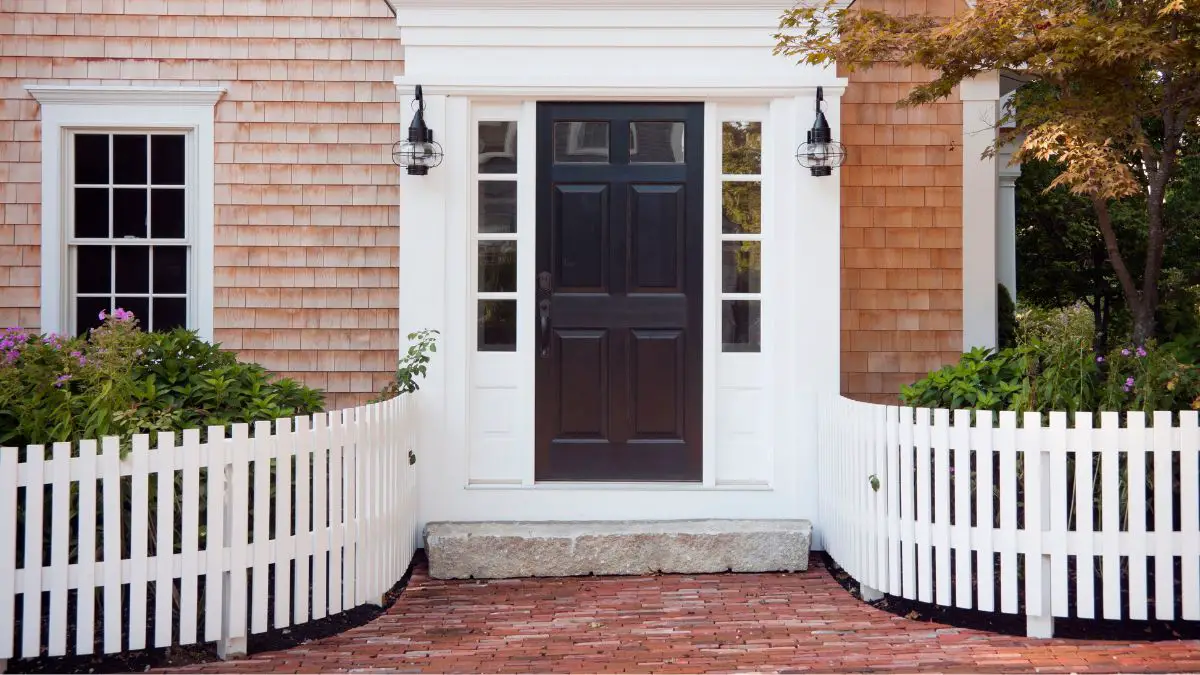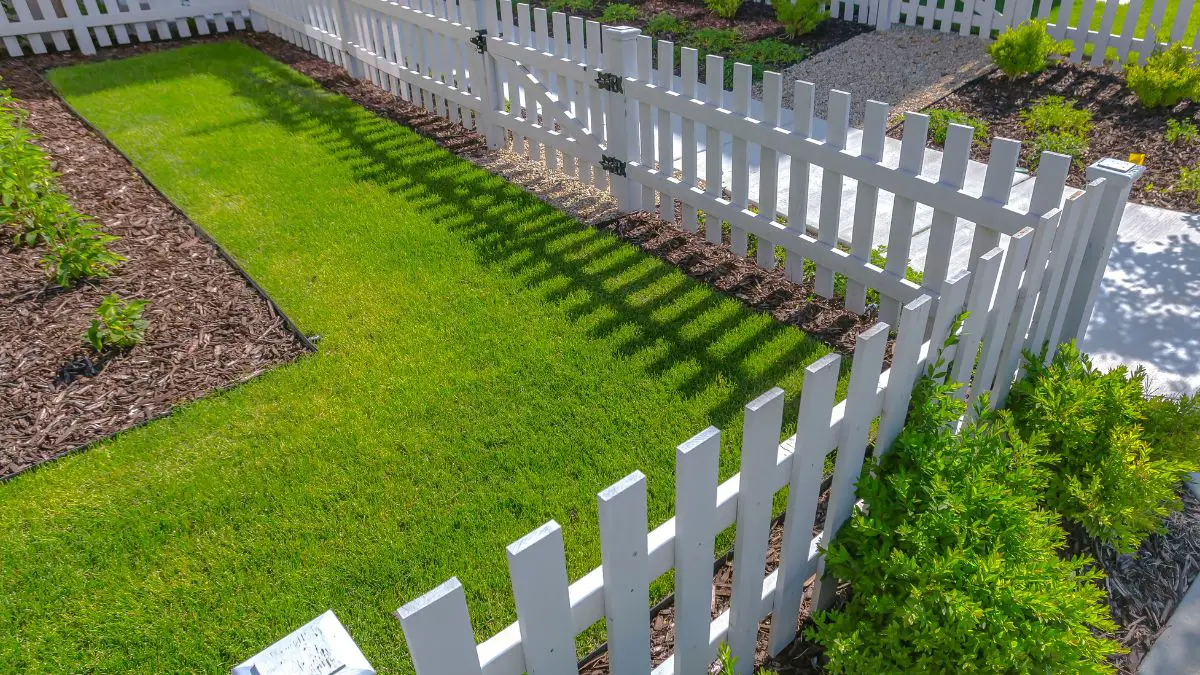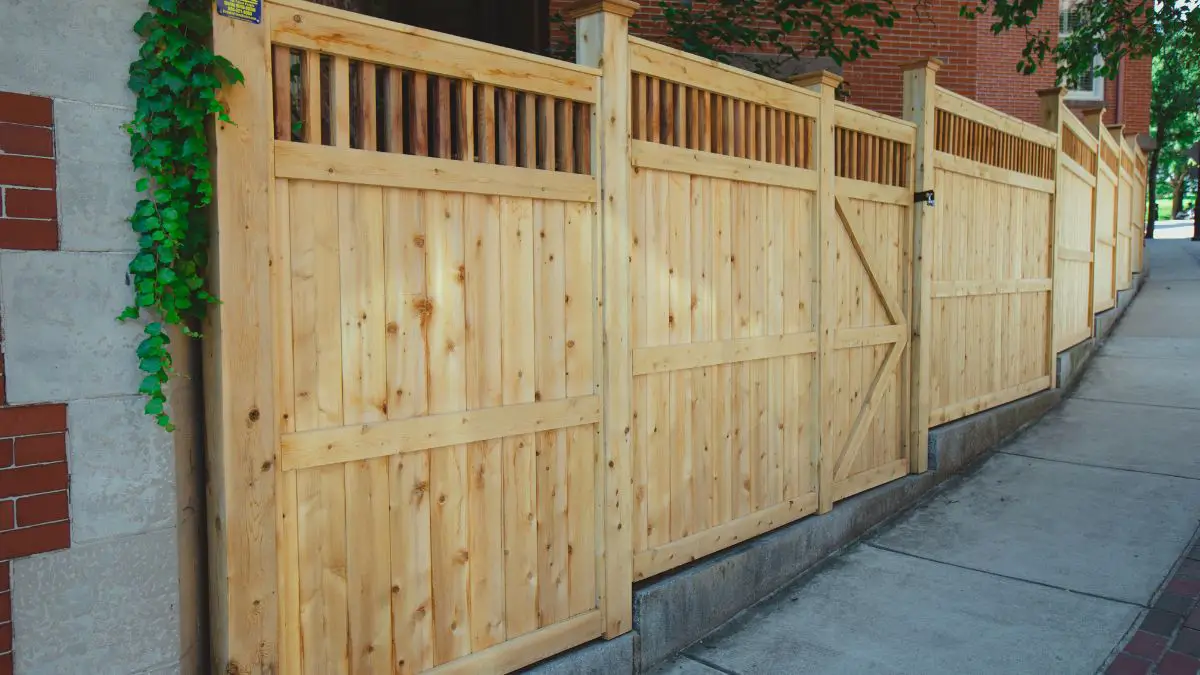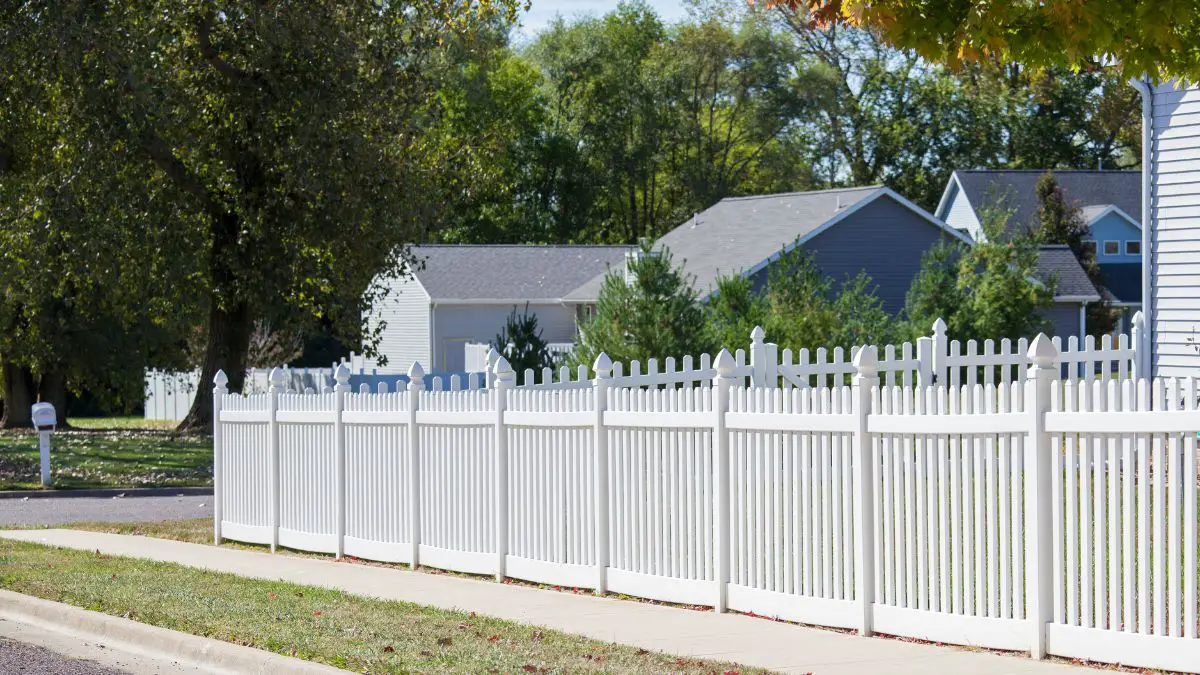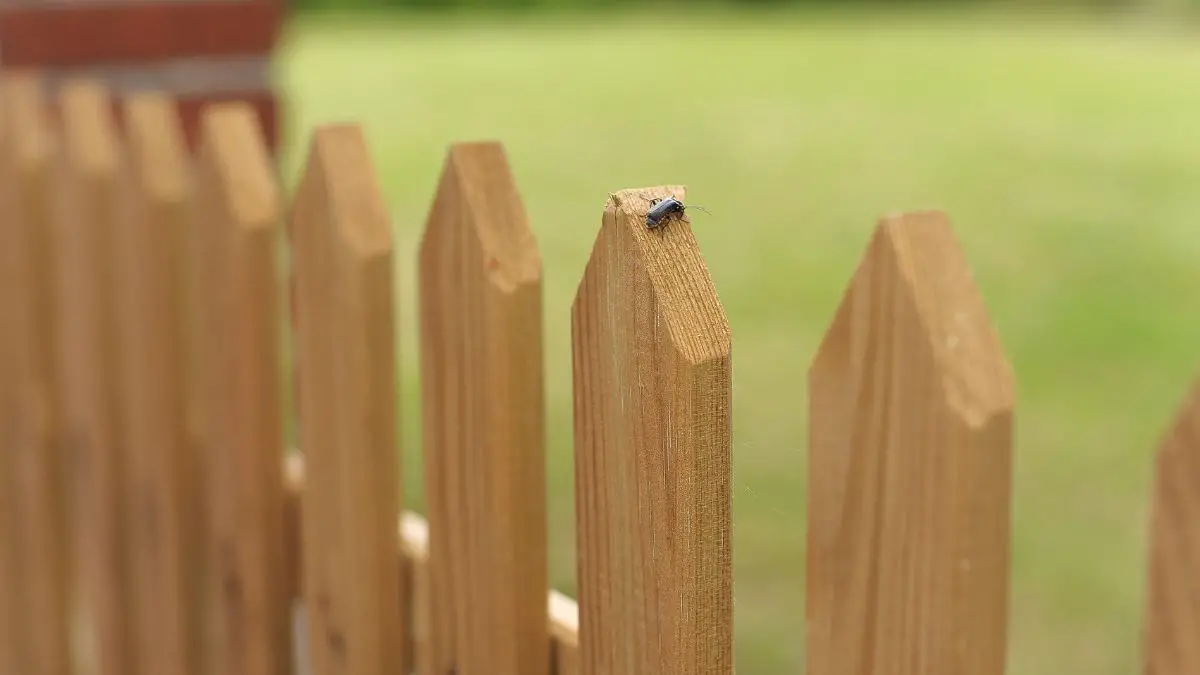The importance of building a fence on a slope cannot be overstated. A well-constructed fence provides security, delineates your property, and increases your home’s value. More than that, it can enhance the beauty of your landscape.
A fence that follows the natural slope of your land creates a harmonious balance between built structures and the natural world. It’s not just a barrier; it’s a statement of style and a testament to your home’s uniqueness. Building a fence on a slope is not just necessary for many homeowners with hilly terrains, but it also adds a unique element of design that can set your property apart.
Building a fence on a slope is a task that requires careful planning and execution. You’ll need to consider the type of fence suitable for slopes, the installation method, and the fence materials.
But don’t worry. This guide is here to help you navigate these challenges. With a mixture of patience, precision, and practical know-how, you can build a fence on a slope that is both functional and beautiful. So, let’s get started on this exciting journey of transforming your sloping land into a fenced paradise.
Get FREE quotes from local fence contractors in your area today. Whether you need wood, vinyl, or metal fencing - We Can Help! All Contractors are screened, licensed, and insured.
Grasping the Basics: Key Terms, Slopes, and Suitable Fences
Before you embark on your fence-building journey, it’s crucial to familiarize yourself with some key terms. Understanding these terms will make the process smoother and ensure you’re well-equipped to handle any challenges that come your way.
Gradient: This is the steepness of your slope, measured as a ratio of vertical change to horizontal distance. It’s a crucial factor in planning your fence layout.
Post: This is the vertical component of your fence, anchored into the ground. It provides the primary support for your fence panels.
Panel: This is the section of the fence that spans between two posts. Panels can be made of various materials, including wood, vinyl, and metal.
Stepped Fencing: This is a method of fence installation option where the panels are level, but the posts are installed at different heights to follow the slope. It gives a ‘stepped’ appearance.
Racked Fencing: Also known as contoured fencing, this method involves shaping the fence panels to follow the slope’s gradient. The top of the secure fence forms a smooth line parallel to the hill.
Hybrid Fencing: This is a combination of stepped and racked fencing. It’s often used when the slope is irregular or when aesthetic considerations demand a more customized approach.
Now that you’re familiar with the key terms let’s delve into the types of slopes and how they affect fence building. Generally, slopes can be categorized as gentle, moderate, or steep.
A gentle slope has a gradient of less than 5%, a moderate slope ranges from 5% to 15%, and a steep slope is anything above 15%. The steeper the hill, the more challenging it is to build a secure fence. You’ll need to consider factors like soil stability, water runoff, and the visual impact of the fence.
Different types of fences are suitable for slopes, and your choice will depend on your specific needs, the slope’s gradient, and your aesthetic preferences.
- Wooden Fences: These are versatile and can be adapted to fit most slopes. They can be installed using either the stepped or racked method. However, they require regular maintenance to prevent rot and weather damage.
- Vinyl Fences: These are durable and require little maintenance. They can be installed using the stepped method, but most vinyl fence panels are not flexible enough for the racked method.
- Metal Fences: These are sturdy and can withstand harsh weather conditions. They’re suitable for steep slopes and can be installed using the racked method.
- Chain Link Fences: These are cost-effective and highly adaptable to slopes. They can be installed using the racked method, making them a good choice for uneven terrain.
Remember, the type of fence you choose should suit your slope and align with your home’s style and personal taste. With a clear understanding of the basics, you’re ready to take the next step in your fence-building journey.
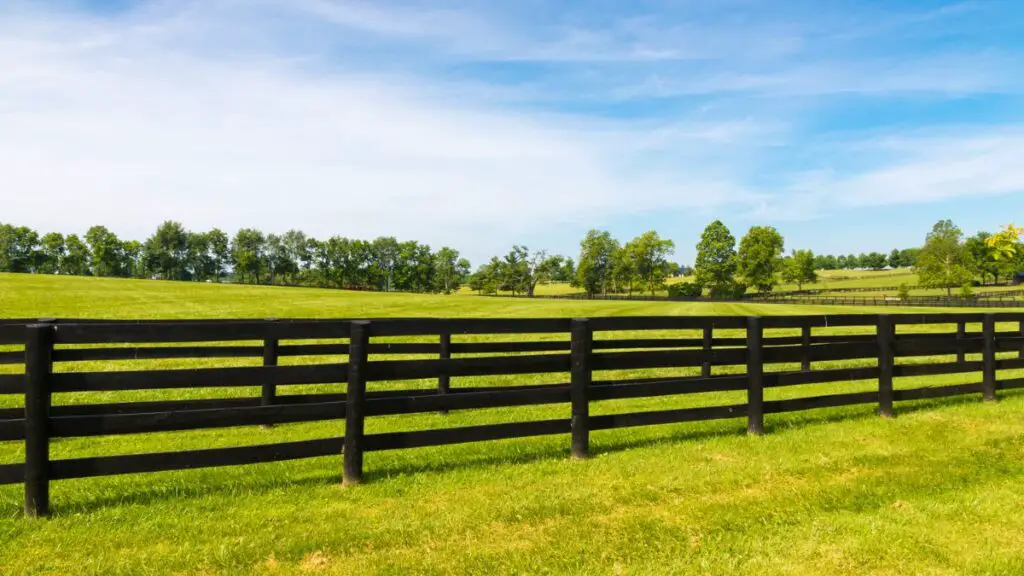
Preparing for Your Fence-Building Project: Evaluating, Gathering, and Safeguarding
Building a fence on a slope is an exciting, beautiful fence project. But some essential groundwork must be done before you start digging post holes. This preparation phase is crucial to ensure your fence is sturdy, durable, and aesthetically pleasing.
Evaluating the Land
First things first, you need to evaluate your land. This involves assessing the gradient of your slope, the type of soil, and any potential obstacles like rocks or trees.
You’ll also need to consider how water runoff might affect your fence. To ensure stability, a steep slope with loose soil may require additional measures, like retaining walls or terracing.
Take the time to measure your slope accurately. Use stakes and a string level to determine the gradient and plot where your fence posts will go. Careful planning at this stage can save you time and effort later on.
Gathering Necessary Tools and Materials
Once you’ve evaluated your land, it’s time to gather your tools and materials. Depending on the type of fence you’re building, you might need the following:
- Fence posts and panels
- Post hole digger
- Level
- String line
- Concrete mix
- Gravel
- Screws or nails
- Saw
- Drill
- Safety gear (gloves, safety glasses)
Remember to choose high-quality materials that can withstand the elements and the test of time. Your fence is an investment; using durable materials will ensure it adds value to your property for years.
Safety Precautions
Building a fence on a slope involves some physical labor, and it’s essential to prioritize safety. Here are some safety precautions to keep in mind:
- Always wear appropriate safety gear, including gloves, safety glasses, and sturdy footwear.
- Be mindful of your posture when digging or lifting to avoid back strain.
- Keep your work area tidy to prevent tripping hazards.
- If you’re using power tools, ensure they’re in good working order and use them with caution.
- Stay hydrated and take regular breaks, especially if you’re working in hot weather.
Building a fence on a slope may seem daunting, but with careful preparation, it’s a task you can tackle with confidence. By evaluating your land, gathering the right tools and materials, and prioritizing safety, you’re setting the foundation for a successful project. So, roll up your sleeves and get ready to transform your sloping yard into a fenced sanctuary.

Methods of Building a Fence on a Slope
Building a fence on a slope requires a different approach than building on flat ground. You can use three methods: stepped fencing, racked or contoured, and hybrid fencing. Each has advantages and challenges; the best choice depends on your specific slope and aesthetic preferences.
Stepped Fencing: Embracing the Steps
Stepped fencing is a popular method for building a fence on a slope. As the name suggests, this method creates a stepped appearance, with each fence panel level at a different height to match the pitch. It’s a great way to highlight the natural contours of your land and can be used with various types of fences, including wood and vinyl.
To build a stepped fence, install the fence posts as you would on flat ground. However, instead of keeping the tops of the posts level, you adjust each post to match the slope gradient. This means each post will be a different height, creating a ‘step’ effect.
Once the posts are installed, you attach the fence panels. Each panel is level but sits at a different height on the slope. The result is a fence that follows the slope in a series of steps.
Racked or Contoured Fencing: Flowing with the Slope
Racked or contoured fencing is another way to build a slope fence. This method involves shaping the fence panels to follow the slope gradient. The top of the fence forms a smooth line parallel to the slope, creating a harmonious look that blends with the landscape.
Racked fencing is particularly suitable for gentle to moderate slopes and works well with flexible materials like metal and some types of wood. However, vinyl fences are not usually recommended, as most vinyl panels are not flexible enough to be racked.
Hybrid Fencing: The Best of Both Worlds
Hybrid fencing is a combination of stepped and racked fencing. It’s often used when the slope is irregular or when aesthetic considerations demand a more customized approach. With hybrid fencing, some sections of the fence may be stepped, while others are racked, depending on the specific contour fence of the slope.
Building a hybrid fence requires careful planning and understanding of the stepped and racked methods. But the result can be a unique and visually appealing fence that perfectly complements your sloping yard.
Building a fence on a slope may seem daunting, but you can create a functional and beautiful fence with these methods.
Whether you choose stepped, racked, or hybrid fencing, you’ll add a valuable feature to your property that enhances its character and charm. So, take a deep breath, pick up your tools, and get ready to build a dream fence that will stand the test of time.
Beautiful Fence Idea for Fences on Slopes
Here are captivating sloped fence ideas for those planning to build on a slope.
Stepped Wood Fence:
A beautiful stepped wooden fence design is a fantastic choice for sloping yards. This design follows the natural contour fence of the land, creating a series of steps.
It offers a beautiful aesthetic and ensures stability and security. The stepped design also improves visibility, which can enhance security. With various wood types and stain colors, a stepped wood attractive fence can add beauty and functionality to your outdoor space.
Stepped Iron Fence:
A stepped iron fence is a striking addition to any property. Its sturdy construction, intricate ironwork, and a stepped design that follows the natural slope create a visually stunning fence that adds security and elegance to your outdoor space.
Gradually Sloping Wood Fence:
A gradually sloping wood fence can create a decorative look in any outdoor space. This type of fence is practical for yards with uneven ground surfaces, as it maintains a consistent height on both sides while keeping the overall design visually appealing.
Stepped Wood Privacy Fence:
A stepped wood privacy fence can enhance the design of your home while providing added security. This type of fence is typically constructed with vertical fence posts and horizontal fence rails but with a unique twist. The posts are staggered or stepped up in height, creating an eye-catching visual effect.
Building a stepped wood privacy fence involves several key steps:
- Mark the Fence Line: Use stakes and string to outline where your fence will go. This will help you visualize the ‘steps’ and determine where each post will be installed.
- Dig the Post Holes: Using a post hole digger, dig a hole for each post. The depth of the hole should be about one-third the height of the post.
- Install the Posts: Place a post in each hole, adjusting the height of each post to match the slope. Fill the hole with concrete, ensuring the post is level before the concrete sets.
- Attach the Panels: Once the concrete has been set, attach the wood panels to the posts. Each panel should be level, creating the ‘step’ effect.
- Seal and Stain: To protect your wood fence from weather damage, apply a sealant and stain the wood for added protection and aesthetic appeal.
Wood Fence with Retaining Wall:
A wooden privacy fence with a retaining wall adds aesthetic value to your yard and can be used to define property lines and create privacy. A retaining wall underneath the wooden fence further increases its stability and lifespan.
Stepped Wire Fence:
A stepped wire fence is a type of fencing that provides both security and aesthetic appeal. The fence is made up of metal posts connected by wires. These posts are stepped down along the length of the fence, creating an eye-catching design feature.
Gradually Sloping Metal Fence:
A gradually sloping metal fence is a perfect combination of strength and fence style. It’s minimalist design and clean lines add a sleek and modern look to your property, while the gradual slope creates a sense of flow and harmony with the surrounding landscape.
Terraced Garden Fence on a Slope:
Terraced garden fences are a great way to add depth and dimension to your landscape while providing privacy and security. By building a fence on a sloping terrain, you can create a series of flat, level areas that can be used for planting, seating, or entertaining.
Gabion Wall Fence on a Slope:
Gabion wall fences are a unique and stylish way to add a modern touch to your property. Gabion walls are made of wire cages filled with rocks or other materials, creating a natural and rustic look that can complement any landscape.
Benefits of a Gabion Wall Fence
- Erosion Control: They prevent soil from being washed away on slopes.
- Structural Stability: They are sturdy and can withstand significant pressure.
- Aesthetic Appeal: They have a natural, rustic look that blends with the landscape.
- Permeability: They allow water to pass through, aiding soil drainage.
- Versatility: They can be built to various heights and shapes for different needs.
- Low Maintenance: They require minimal upkeep once installed.
- Environmentally Friendly: They are made from natural or recycled materials.
- Cost-Effective: They are generally less expensive than other retaining walls.
- Durability: They can withstand harsh weather conditions.
- Noise Reduction: The stones within the gabion baskets can help absorb and reduce noise.
Living Fence on a Slope:
Living wall fences are a great way to add beauty and functionality to your property. These fences comprise living plants and vegetation that can be grown on a trellis or other support structure.
Alternating Retaining Wall Fence:
An alternating retaining wall fence is a type of fencing project built on a slope using alternating levels of retaining walls and fencing panels.
This type of fence is a great way to add a unique and visually appealing element to your landscape while providing practical benefits such as erosion control and soil retention.
Dog Ear Wood Picket Fence on a Slope:
A dog ear wood picket fence is a classic choice that brings a sense of nostalgia and charm. This fence consists of evenly spaced vertical pickets with the top corners angled inward, hence the term ‘dog ear.’
This entire fence is traditionally constructed from white-painted, treated pine but can be customized with other types of wood. Building a dog ear fence on a slope requires careful planning due to the unique challenges posed by the sloped terrain.
Chain Link Fence on a Slope:
A chain link fence idea on a slope is a popular and cost-effective fencing option that can be installed on various terrains, including slopes. This creative fence idea comprises interwoven metal wire mesh that creates a diamond pattern, resulting in a strong and sturdy fence design.
Many fencing options are available for installing a fence on a slope. From wooden panels with metal fencing to gabion wall fences, each fencing option offers unique benefits and designs. It’s important to consider the slope’s contour and select a fence design that complements the property’s overall look and style.

Your Step-by-Step Guide to Building a Fence on a Slope
Building a fence on a slope is a rewarding project that enhances your property’s security, privacy, and aesthetic appeal. Let’s break down the step-by-step process for each method: stepped, racked, and hybrid fencing.
Stepped Fencing: A Step-by-Step Guide
- Mark the Fence Line: Use stakes and string to mark out the line where your fence will go. The string will help you visualize the ‘steps’ and determine where each post will go.
- Dig the Post Holes: Using a post hole digger, dig a hole for each post. The depth of the hole should be about one-third the proper height of the post.
- Install the Posts: Place a post in each hole. Adjust the exact height of each post so that the top aligns with the slope. Fill the hole with concrete, ensuring the post is level before the concrete sets.
- Attach the Panels: Once the concrete has been set, attach the fence panels to the posts. Each panel should be level, creating a ‘step’ effect.
Racked Fencing: A Step-by-Step Guide
- Mark the Fence Line: As with stepped fencing, start by marking out the line where your fence will go.
- Dig the Post Holes: Dig a hole for each post. For racked fencing, the tops of the posts should be level, so you may need to dig deeper for posts on higher parts of the slope.
- Install the Posts: Place a post in each hole and fill the hole with concrete. Use a level to ensure each post is straight.
- Attach the Panels: Attach the fence panels to the posts, adjusting each panel to follow the slope. This may require cutting the panels at an angle to fit correctly.
Hybrid Fencing: A Step-by-Step Guide
- Mark the Fence Line: Mark out where your fence will go. For hybrid fencing, you’ll need to decide which sections will be stepped and which will be racked.
- Dig the Post Holes: Dig a hole for each post. The depth of each hole will depend on whether the fence sections will be stepped or racked.
- Install the Posts: Install the posts, adjusting the height for stepped sections and keeping the tops level for racked sections.
- Attach the Panels: Attach the panels using the stepped method for stepped sections and the racked method for racked sections.
Remember, building a fence on a slope requires patience and precision. But with careful planning and execution, you can create a functional and beautiful fence. So, put on your safety gear, gather your tools, and get ready to transform your sloping yard into a fenced paradise.
Maintaining Your Fence on a Slope: Regular Checks and Weather Considerations
Congratulations! You’ve successfully built your fence on a slope. But your journey doesn’t end here. Regular maintenance and care ensure your fence stands strong and looks great for years.
Regular Checks and Repairs
Your fence is exposed to the elements 24/7 and can experience wear and tear over time. Regular checks can help you spot potential issues early and address them before they become major problems.
Here’s a simple routine you can follow:
- Visual Inspection: Walk along your fence line at least once a month. Look for signs of damage, such as cracked or loose panels, rotting wood, or rust on metal fences.
- Post Check: Give each post a gentle shake to ensure it’s firmly in the ground. Loose posts can destabilize your fence, especially on a slope.
- Gate Check: If your fence has a gate, check that it opens and closes smoothly. Look for signs of sagging or misalignment.
- Repairs: If you spot any issues during your checks, address them promptly. Small repairs, like replacing a cracked panel or tightening a loose screw, can prevent more significant damage.
Weather Considerations
Weather can significantly impact your fence, especially if you live in an area with harsh climates. Here are some weather considerations to keep in mind:
- Rain and Humidity: Excessive moisture can cause wood to rot and metal to rust. Consider using water-resistant materials or treatments if you live in a rainy area. After heavy rain, check your fence for water damage.
- Wind: Strong winds can put a lot of pressure on your fence, especially tall ones. After a storm, check your fence for any signs of wind damage, such as loose panels or leaning posts.
- Sun: Prolonged exposure to the sun can fade the color of your fence and make wood brittle. Consider using UV-protective finishes to help your fence withstand the sun’s rays.
- Snow and Ice: In cold climates, snow, and ice can cause the ground to freeze and expand, shifting fence posts. After winter, check your fence posts to ensure they’re still level and secure.
Maintaining a fence on a slope may require more effort than on flat ground, but it’s well worth it. With regular checks and repairs, and by considering the impact of weather, you can ensure your fence remains a beautiful and secure feature of your property for many years to come.
So, grab your gloves, step outside, and give your fence the care it deserves.
FAQs About Building a Fence on a Slope
Can I build a fence on any type of slope?
Yes, you can build a fence on almost any slope. However, the steeper the slope, the more challenging the project. Stepped, racked, or hybrid fencing can accommodate a variety of slopes.
What type of fence is best for a slope?
The best type of fence for your slope depends on the gradient and your personal preferences. Wood, metal, and chain link fences can be adapted to fit most slopes. Vinyl fences can work but are typically better suited for stepped rather than racked installation.
How do I maintain a fence on a slope?
Maintaining a fence on a slope involves regular checks for damage, prompt repairs, and consideration of weather impacts. Regular visual inspections, post and gate checks, and promptly addressing any issues can help keep your fence in shape.
Can I build a fence on a slope myself?
Yes, with the right tools, materials, and a good understanding of the process, you can build a fence on a slope yourself. However, you might consider hiring a professional for steep slopes or large projects.
Wrapping Up: The Art of Building Fence on Slope
Building a fence on a slope is more than just a practical solution for security and privacy. It’s an opportunity to enhance the beauty of your landscape to create a harmonious balance between built structures and the natural world. Whether you choose stepped, racked, or hybrid fencing, you’re adding a unique element of design that sets your property apart.
But this journey isn’t without its challenges. From evaluating the land and gathering the necessary tools and materials to navigating the complexities of different slopes and fence types, building beautiful fencing on a slope requires patience, precision, and practical know-how.
Yet, with the knowledge you’ve gained, you’re well-equipped to tackle these challenges. You’re ready to build a fence that is a sturdy, durable fence, and aesthetically pleasing. So, take a deep breath, pick up your tools, and get ready to transform your sloping yard into a fenced paradise. Your journey to building a fence on a slope starts now.


